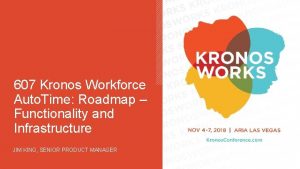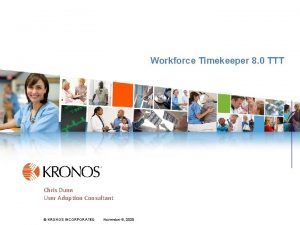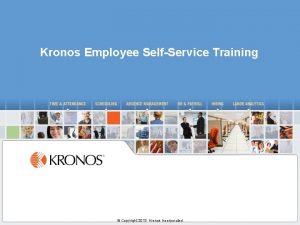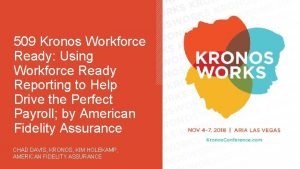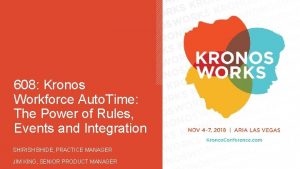Workforce Institute Research Project May 28 2008 Kronos








- Slides: 8

Workforce Institute Research Project May 28, 2008 Kronos Internal Use Only 1

Research Project Background • Research Question – What on-boarding practices influence the engagement and retention of new hires in the hourly workforce? • Research Objectives – Gain insight into what practices are being used by organizations to on-board hourly workers – Determine how long the on-boarding process typically lasts for hourly workers – Identify practices within the on-boarding process that foster new hire engagement and mitigate early attrition • Context – Global war for talent • Shrinking and younger pool of skilled talent • Greater importance on retaining and developing talent – Effective on-boarding process is becoming a must Kronos Internal Use Only 2

Hourly Context • Hourly workforces across industries are prone to extremely high rates of employee turnover – It is not unusual for 50% of a company’s frontline employees to leave within 120 days of their hire date An effective on-boarding process should improve these results The first weeks and months of the job are critical to speed up productivity and foster retention Kronos Internal Use Only 3

Goals of the On-Boarding Process Tasks Better understanding of the responsibilities and tasks for he/she was hired Team Development of effective work relationships Organization Better understanding of the company structure, goals, history, and culture Expectancies Better alignment with tasks, compensation, team, and training expectations • On-boarding consists of orienting new employees to their specific job tasks and associated work expectations as well as socializing them into the company’s norms, culture, and team dynamics Kronos Internal Use Only 4

Phases of the Research Project • Phase 1 – Conduct new hire frontline and supervisor interviews – Collect qualitative information about perceptions of and experiences with the on-boarding process – Finalize the new hire survey for phase 2 • Phase 2 – Administer the new hire survey to individuals after being employed for X days • Number of days to be determined by Phase 1 results – Analyze the quantitative relationships between on-boarding practices, employee engagement, and subsequent new hire retention – If possible, analyze any differences in the results based on industry Kronos Internal Use Only 5

Project Steps to Date • Phase 1 – Literature review and presentation attendance • Employee engagement • On-boarding – On-boarding survey review • Kronos • Aberdeen – Client-facing collateral – Interviewer script – Interviewee informed consent – Supervisor interview guide – New hire interview guide • Phase 2 – Draft new hire survey for review by Phase 1 participants Kronos Internal Use Only 6

Client Participation in Phase 1 Customer Vertical Status – May 2008 Joe’s Sporting Goods Retail Beginning Phase 1. May 23, 2008 – meeting scheduled to identify survey store locations. Genesis Healthcare Beginning Phase 1. June 10, 2008 – meeting scheduled to identify survey facility locations. Big Y Grocery Reviewing project documentation. Super. Valu Grocery Reviewing project documentation. Kohl’s Retail Reviewing project documentation. CVS Retail Not available to participate in the project at this time. Kronos Internal Use Only 7

Aberdeen Group Study • 70% of all organizations are using on-boarding as a strategy to improve new employee retention • Those organizations that achieved best-in-class designation in on-boarding saw the following results: – 100% improved retention rates of new hires – 60% reduced time to productivity for new hires – 57% increased completion rate of on-boarding activities Kronos Internal Use Only 8



